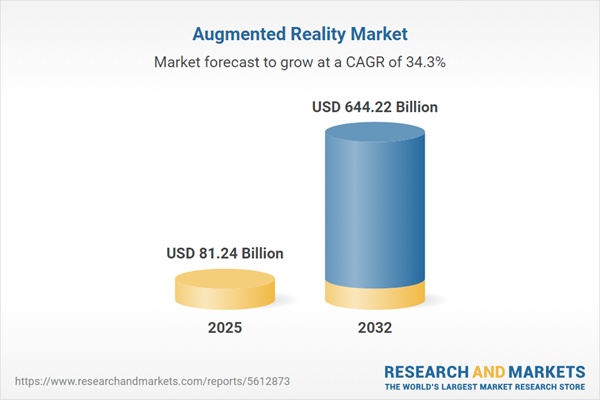Speak directly to the analyst to clarify any post sales queries you may have.
Augmented reality (AR) is rapidly transforming as a pivotal enterprise technology, offering senior decision-makers strategic advantages for operational efficiency, workforce enablement, and meaningful customer engagement. Comprehensive augmented reality market research empowers organizations to make evidence-based investments and navigate the accelerating pace of digital transformation with confidence.
Market Snapshot: Augmented Reality Market Growth and Outlook
The global augmented reality market is experiencing sustained expansion, demonstrated by robust compound annual growth rates and increasing market size. Enterprises in key industries have moved past exploratory projects to widespread AR adoption, embedding advanced solutions within core workflows. This market evolution is driven by maturing AR platforms, improved connectivity, and specialized software capabilities. Sectors such as manufacturing, retail, and healthcare are at the forefront, leveraging AR to increase productivity, support agile operations, and ensure business continuity in unpredictable environments. AR’s ability to facilitate rapid adaptation and process optimization is proving critical as organizations respond to fluctuating market dynamics and stakeholder expectations.
Scope & Segmentation: Strategic Augmented Reality Insights
- Component: Enterprise AR is deployed through dedicated glasses, head-mounted displays, handheld devices, and spatial screens, each underpinned by advanced software platforms and essential technical services, including integration and ongoing maintenance.
- Technology: Both marker-based and markerless AR options are available, providing versatility for business requirements—from optimizing industrial procedures to elevating client interaction.
- Interaction Mode: Multiple input options, such as gesture controls, eye tracking, voice commands, touch interfaces, and next-generation brain-computer interfaces, enable seamless workflow integration and enhance user experience.
- End-Use: Organizations in automotive, electronics, education, finance, defense, retail, healthcare, marketing, media, tourism, travel, and manufacturing sectors utilize AR for efficiency gains and enriched process management.
- Application: Key uses include digital overlays, live object recognition, site mapping in real time, remote support channels, annotated visualization, navigational aids, and collaborative displays that promote knowledge transfer and streamline operations.
- Regional Coverage: Adoption is strong in the Americas, Europe, Middle East, Africa, and Asia-Pacific. Countries like China, India, Japan, Singapore, Australia, and South Korea are especially prominent due to infrastructure maturity and supportive regulation, making them favorable for continued AR investment growth.
- Leading Companies: Innovation is steered by organizations such as Apple, Google, Meta Platforms, Lenovo, Magic Leap, NVIDIA, PTC, Qualcomm Technologies, Samsung Electronics, Seiko Epson, Snap, Sony, TeamViewer, The LEGO Group, Vuzix, Wikitude, Xiaomi, Zappar, Zugara, and Blippar, all of which are prioritizing scalable enterprise-level AR implementations.
Key Takeaways: Strategic Insights for Decision-Makers
- Adopting AR platforms with ergonomic design and intuitive user interfaces streamlines workforce onboarding and supports efficient large-scale deployment.
- Standardized and open AR architectures simplify system integration, minimize migration challenges, and foster long-term compatibility across business units.
- Advanced AR capabilities, such as gesture- and AI-powered controls, help organizations bolster regulatory compliance and maintain precision in mission-critical processes across industries.
- Working alongside experienced integrators and managed service partners accelerates deployment, expedites troubleshooting, and fortifies systemic stability throughout the AR project lifecycle.
- Cross-industry collaboration between AR vendors, research bodies, and regulators accelerates application development and lays the foundation for global adoption frameworks.
- Customizing AR strategies to local regulatory conditions and infrastructure landscapes is vital for optimizing speed-to-deployment, costs, and intended business outcomes.
Tariff Impact: Navigating Supply Chain and Cost Structure Shifts
Recent U.S. tariff adjustments have increased import costs for AR hardware, leading enterprises to diversify supplier bases and prioritize domestic sourcing. This strategic shift enhances supply chain resilience and underpins stable device pricing, securing the infrastructure required for continuous business operations.
Methodology & Data Sources
Insights in this report derive from interviews with senior executives, comprehensive patent analyses, and input from leading industry associations. The approach integrates SWOT and PEST frameworks, supporting thorough risk analysis and opportunity discovery in augmented reality investments.
Why This Report Matters
- Actionable AR market trends enable senior leaders to inform investment decisions and design responsive strategies that align with evolving enterprise technology priorities.
- Focused recommendations tie digital transformation efforts to unique sector needs, strengthening organizational risk management and strategic alignment.
- Objective supplier assessments enhance the vendor selection process, supporting lasting partnerships for scalable enterprise AR initiatives.
Conclusion
Augmented reality is redefining enterprise collaboration and operational processes. This analysis equips decision-makers to seize new opportunities and guide their organizations successfully through the ongoing evolution of digital business landscapes.
Additional Product Information:
- Purchase of this report includes 1 year online access with quarterly updates.
- This report can be updated on request. Please contact our Customer Experience team using the Ask a Question widget on our website.
Table of Contents
3. Executive Summary
4. Market Overview
7. Cumulative Impact of Artificial Intelligence 2025
Companies Mentioned
The companies profiled in this Augmented Reality market report include:- Apple, Inc.
- Blippar Group Limited
- Google LLC
- Lenovo Group Ltd.
- Magic Leap, Incorporated
- Meta Platforms, Inc.
- NVIDIA Corporation
- PTC Inc.
- Qualcomm Technologies, Inc.
- Samsung Electronics Co. Ltd.
- Seiko Epson Corporation
- Snap, Inc.
- Sony Corporation
- TeamViewer SE
- The LEGO Group
- Vuzix Corporation
- Wikitude GmbH
- Xiaomi Corporation
- Zappar Limited
- Zugara, Inc.
Table Information
| Report Attribute | Details |
|---|---|
| No. of Pages | 192 |
| Published | November 2025 |
| Forecast Period | 2025 - 2032 |
| Estimated Market Value ( USD | $ 81.24 Billion |
| Forecasted Market Value ( USD | $ 644.22 Billion |
| Compound Annual Growth Rate | 34.3% |
| Regions Covered | Global |
| No. of Companies Mentioned | 21 |









